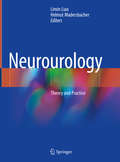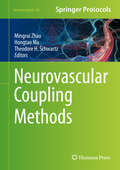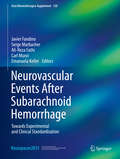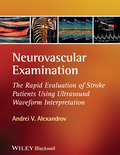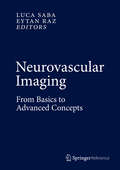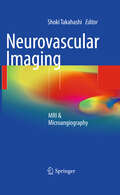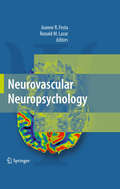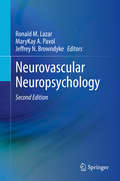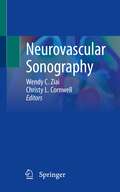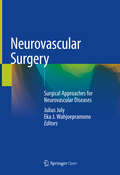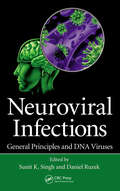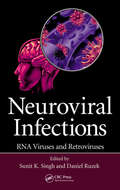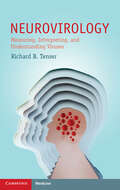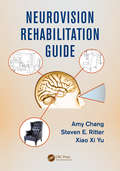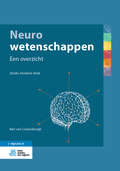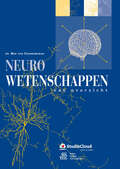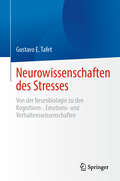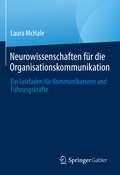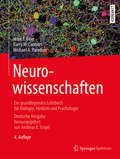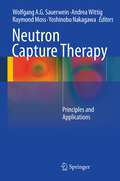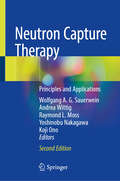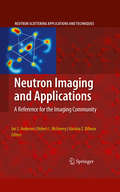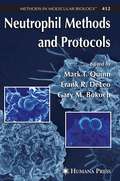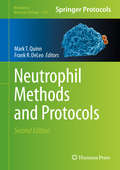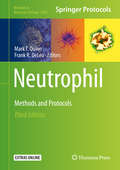- Table View
- List View
Neurourology: Theory And Practice
by Limin Liao Helmut MadersbacherThis book introduce neurourology as an emerging interdisciplinary area that covers the basic and clinical studies of the neural control on the normal lower urinary tract and the lower/upper urinary tract dysfunction due to neuropathy disorders. It systematically describes all aspects of neurourology from the epidemiology of the neurogenic bladder; to the pathology and pathophysiology of the lower urinary tract; to the diagnosis and treatment of the neurogenic bladder by conservative therapies or surgeries. This book provides a useful resource for medical doctors, nurses and students in the field of neurourological conditions. All the topics are written by internationally recognized specialists in their field.
Neurovascular Coupling Methods
by Mingrui Zhao Hongtao Ma Theodore H. SchwartzNeurovascular Coupling Methods brings the reader up to date with the current state-of-the-art techniques in measuring blood flow in the brain, with chapters describing different techniques or combinations of techniques, applied to specific species in either healthy or abnormal brains. Opening with a section on techniques in normal somatosensory processing, the detailed volume continues with parts covering techniques in normal visual processing, epilepsy and cerebrovascular diseases, such as ischemia, hemorrhage and spreading depression As a collection in the popular Neuromethods series, this book contains the kind of thorough description and implementation advice that will lead to successful results in the lab. Authoritative and practical, Neurovascular Coupling Methods serves as an ideal guide for researchers aiming to further our knowledge of these coupling mechanisms in the hopes of ultimately understanding higher order functions such as language and memory and developing novel brain mapping techniques that can be employed in humans.
Neurovascular Events After Subarachnoid Hemorrhage
by Javier Fandino Serge Marbacher Ali-Reza Fathi Carl Muroi Emanuela KellerThis book contains articles presented at the 12th International Conference on Cerebral Vasospasm, held in Lucerne, Switzerland, in July 2013. The included papers represent a balanced cross-section of the enormous progress achieved in basic and clinical research on aneurysmal subarachnoid hemorrhage and its sequelae, including early neurovascular events and delayed cerebral vasospasm. The section on basic research covers a broad range of aspects, with a special focus on animal models for the study of acute events after experimental subarachnoid hemorrhage. The section on clinical topics encompasses imaging and endovascular management, surgical innovations and techniques, management and monitoring in neurocritical care, the status of clinical trials, and factors involved in aneurysm formation. This edition is of interest not only for basic researchers but also for clinicians who wish to apply state-of-the-art knowledge to the research and management of this devastating condition.
Neurovascular Examination
by Andrei V. AlexandrovThe use of neurovascular ultrasound is of increasing importance in neurological practice, both for radiologists and increasingly by neurologists themselves. Written by the world's most renowned expert, this book explainsultrasound examination of a stroke patient scanning protocols interpretation of the results Case examples (with a standard template presentation correlating presentation to waveform output) reinforce the book's practical nature. Illustrated with photos of the tests, explanations, and with actual waveforms, images, and result interpretation, and enhanced with 'pearls' and 'avoiding pitfalls' features, it is a practical reference for those learning ultrasound as well as those using ultrasound in their practices.
Neurovascular Imaging
by Luca Saba Eytan RazVascular Neurology, Vascular Neurosurgery and Interventional Neuroradiology are independent fields with dedicated Training Programs. Neuroimaging, and in particular what we call "Neurovascular Imaging" is a unifying factor which can be considered the intersection of these three medical specialties. With this book we aim to cover thoroughly the imaging techniques, potentialities, and present and future applications as applied to all the vascular diseases of the central nervous system from the imaging point of view. This book will comprise eight main sections: (1) The Basics, (2) Arteries of the Head and Neck (3) The basics of Intracranial Arteries (4) Diseases of the vessels (5) Stroke Imaging (6) Veins Imaging (7) Spine Imaging (8) Pediatrics.
Neurovascular Imaging
by Shoki TakahashiThe comparison of MR images and cadaver microangiograms of the basal perforating arteries is crucial for understanding the courses and supply areas of these vessels and in turn, for diagnosing pathologies in this region. Divided into three sections- normal anatomy of brain vessels; neurovascular imaging in pathology; and anatomy and imaging of spinal vessels- Neurovascular Imaging contains a rich collection of images to teach the reader how to interpret MR images of the brain vessels and spinal vessels, and how to identify pathological signs. Written and edited by a group of highly acclaimed experts in the field, Neurovascular Imaging is an authoritative account of the interpretation of MR images of the brain vessels and spinal vessels, and is a valuable addition to the library of the diagnostic radiologist.
Neurovascular Neuropsychology
by Joanne Festa Ronald Lazar J. P. MohrNeurovascular diseases and conditions, and their associated risk factors, represent a significant cause of cognitive disability in the United States and throughout the world. In the USA alone there are 750,000 new strokes each year, representing the number one cause of disability in the country. Hypertension, found in approximately 50 million Americans, has been shown to be associated with alterations of cognitive function, even in the absence of stroke and dementia. Recent studies of neurovascular disease have now revealed that neuropsychological function may be a more sensitive measure of brain integrity than coordination, motor or sensory function and correlates will with functional outcome measures. Neurovascular Neuropsychology focuses on focal and diffuse neurovascular disease in addition to systemic conditions in which cognition and behavior have been uniquely associated with different pathologic states. With an increasing number of patients being treated by healthcare professionals, Neurovascular Neuropsychology will prove to be a strong reference to consult in regards to neuropsychological syndromes.
Neurovascular Neuropsychology
by Ronald M. Lazar MaryKay A. Pavol Jeffrey N. BrowndykeThis book covers the explosion of new information about the relationship between the brain and its blood supply since the first edition was published in 2009. With new knowledge and its impact on clinical care, neurovascular neuropsychology has become a recognized sub-specialty that has been integrated into health care systems in the US and abroad. The second edition brings to this larger audience the latest word on these matters, with new emphasis on women’s issues, relevance to the pediatric population, insights from modern imaging, and advances in medical and surgical treatments such as heart transplantation, cardiovascular transarterial therapies, and noninvasive brain stimulation in connection with neurocognitive outcomes.
Neurovascular Sonography
by Wendy C. Ziai Christy L. CornwellThis book provides a comprehensive and concise, review of the fundamental concepts and clinical indications for Transcranial Doppler (TCD) imaging. An overview of the physics of ultrasonography as it pertains to TCD is presented, as well as neuroanatomy and cerebrovascular physiology in healthy and diseased states. Recommended protocols for neuroimaging are reviewed and serves as a guide for existing neurovascular laboratories and medical systems seeking to develop laboratories that are in need of a guide to establish their own protocols. The most common, relevant and challenging clinical conditions where TCD is incorporated to assist with patient management are discussed. In addition, chapters provide a framework for building a neurovascular laboratory, including necessary equipment, steps to obtain national accreditation by accrediting bodies, and reimbursement procedures for tests performed. The book concludes with “clinical pearls” and “tricks of the trade”, which serve as a commentary to guide physicians and neurosonologists on best-practices for TCD acquisition and interpretation.
Neurovascular Surgery: Surgical Approaches For Neurovascular Diseases
by Julius July Eka J. WahjoepramonoThis open access book presents the diagnosis, investigation and treatment of neurovascular diseases, and offers expert opinions and advice on avoiding complications in neurovascular surgery. It also covers complication management and post-operative follow-up care. The book is divided in to three parts; the first part discusses common approaches in neurovascular surgery, describing the steps, indications for and limitations of the approach, as well as the associated complications and how to avoid them. The second part addresses surgical treatment based on pathology, taking the different locations of lesions into consideration. The third part focuses on the technological developments that support neurovascular surgery, which may not be available everywhere, but have been included to help vascular surgeon understand the principles. This book is a guide for young neurosurgeons, neurosurgery residents and neurosurgery fellows, as well as for medical students and nurses who are interested in neurosurgery or are associated with this field in any way. It is also a useful teaching aid for senior neurosurgeons.
Neuroviral Infections: General Principles and DNA Viruses
by Sunit K. Singh Daniel RůžekNeurovirology is an interdisciplinary field representing a melding of virology, clinical neuroscience, molecular pathogenesis, diagnostic virology, molecular biology, and immunology. Neuroviral Infections: General Principles and DNA Viruses covers recent developments in the area of neuroviral infections and discusses their role in related fields su
Neuroviral Infections: RNA Viruses and Retroviruses
by Sunit K. Singh Daniel RuzekNeurovirology is an interdisciplinary field representing a melding of virology, clinical neuroscience, molecular pathogenesis, diagnostic virology, molecular biology, and immunology. Neuroviral Infections: RNA Viruses and Retroviruses presents an up-to-date overview of the general principles of infections and major neuroviral infections caused by RNA viruses and retroviruses. It is designed for virologists, specialists in infectious diseases, teachers of virology, and postgraduate students of medicine, virology, neurosciences, and immunology.
Neurovirology: Measuring, Interpreting, and Understanding Viruses (Cambridge Manuals in Neurology)
by Richard B. TenserThe plethora of miscommunication and disinformation about how SARS-CoV-2 (COVID-19) spreads suggests a widespread misunderstanding of how viruses work. This book will focus on the interpretation of scientific and medical results, giving the reader guidance on interpreting virological data, including the concepts of 'live' versus infectious virus. The first section covers the background of virology and immunology, introducing the reader to the science of virology (using COVID-19 as an illustration) and considers the measurement of infectious disease, using polymerase chain reaction (PCR), molecular biology and the immune system. The second section looks at clinical virology and neurovirology. Taking a novel perspective on how viruses may play a role in evolution, this book discusses antivirals and how autoimmune disorders may be caused or triggered by viruses. Concise and practical, this is a key resource for those working in neurology, infectious disease and virology.
Neurovision Rehabilitation Guide
by Amy Chang Xiao Xi Yu Steven E. RitterNeurovision Rehabilitation Guide is a valuable resource for the health care professional working with patients with visual dysfunction as a consequence of traumatic brain injury and neurological disorders. It covers the concepts of visual dysfunction as well as assessment and step-by-step treatment plans. <P><P>The guide covers the neurology of visual processing before and after a brain injury. It explains the concepts behind neurovision rehabilitation and how to go about examining and treating the patient’s visual deficits. It also covers the evaluation of visual perceptual deficits and treatment of the traumatic brain injury patient. <P><P>The guide contains more than 80 vision therapy procedures, with step-by-step instructions as well as sequencing guides for each category of therapy (oculomotor, accommodation, binocular, perceptual).
Neurowetenschappen: Een overzicht
by Ben van CranenburghDit boek geeft een overzicht over het immense gebied van de neurowetenschappen en kan beschouwd worden als een basistekst met een sterk praktische signatuur. Opvattingen over zenuwstelsel en hersenen worden vanuit veel invalshoeken belicht, o.a. vanuit de neuroanatomie, de neurofysiologie, de klinische neurologie, de psychologie en evolutiebiologie. De auteur heeft getracht de werking van het zenuwstelsel op diverse niveaus inzichtelijk te maken: het microniveau (neuron, synaps), het macroniveau (hersengebieden, hemisferen), het mentale niveau (emoties, cognities) en het gedragsniveau (aangepast handelen). Een klassiek fundament van de neurofysiologie, het reflexmodel, wordt in dit boek gerelativeerd en genuanceerd: menselijk gedrag is niet alleen maar reactief, maar kan ook spontaan geïnitieerd zijn. De hersenen verwerken en verwekken informatie. Simplistische ideeën over de hersenen worden ontzenuwd, bijvoorbeeld de lokalisatie van functies in specifieke centra, het misverstand dat functies als creativiteit en muziek in de rechter hemisfeer gelokaliseerd zijn, het idee dat het volwassen brein niet of minder plastisch zou zijn. Alternatieven die meer in overeenstemming zijn met de huidige opvattingen, worden gepresenteerd. Neurowetenschappen, Een overzicht maakt deel uit van een zesdelige serie ‘Toegepaste neurowetenschappen’. In het boek worden voortdurend verbindingen gelegd met diverse toepassingsgebieden. Motoriek wordt losgemaakt van spieren: de hersenen sturen een ‘symphony of movements’. Het belang van zintuiglijke functies bij (het leren van) motorische vaardigheden (sport, muziek, revalidatie) wordt benadrukt, en de plasticiteit van het zenuwstelsel wordt gepresenteerd als biologische basis voor flexibiliteit, adaptatie, ontwikkeling, leren en herstelprocessen. Nieuwe inzichten betreffende de werking van de hersenschors, de lokalisatie van functies in zogenoemde neurale ensembles (connectomen) en hemisfeerspecialisatie kunnen inspireren tot toepassingen op allerlei gebieden. Geregeld komt het ‘mind-body’-probleem aan de orde: de onscheidbaarheid van soma en psyche die in het zenuwstelsel zijn biologische basis heeft, wordt met talrijke voorbeelden toegelicht. Het boek is ook digital beschikbaar met bij elk hoofdstuk vragen en antwoorden en samenvattingen. Met praktische voorbeelden op het gebied van dagelijks leven, kliniek, therapie, sport, muziek en onderwijs heeft de auteur getracht om de grote kloof tussen neurowetenschappen en praktijk te overbruggen en plaatst daarmee de neurowetenschappen midden in het leven. Kortom, een belangwekkend boek voor medici, paramedici en psychologen, en zeer bruikbaar voor diverse opleidingen.
Neurowetenschappen: een overzicht
by Ben Cranenburgh'Neurowetenschappen, een overzicht', is het eerste deel van de vierdelige reeks 'Toegepaste neurowetenschappen'. Het boek geeft een overzicht over het immense gebied van de neurowetenschappen en kan beschouwd worden als een basistekst met een sterk praktische signatuur. Opvattingen over zenuwstelsel en hersenen worden vanuit veel invalshoeken belicht, o. a. vanuit de neuroanatomie, de neurofysiologie, de klinische neurologie, de psychologie en evolutiebiologie. De auteur heeft getracht de werking van het zenuwstelsel op diverse niveaus inzichtelijk te maken: het microniveau (neuron, synaps), het macroniveau (hersengebieden, hemisferen), het mentale niveau (emoties, cognities) en het gedragsniveau (aangepast handelen). Een klassiek fundament van de neurofysiologie, het reflexmodel, wordt in dit boek gerelativeerd en genuanceerd: menselijk gedrag is niet alleen maar reactief, maar kan ook spontaan geinitieerd zijn. De hersenen verwerken en verwekken informatie. Veel simplistische ideeen over de hersenen worden ontzenuwd, bijvoorbeeld de lokalisatie van functies in specifieke centra, het misverstand dat functies als creativiteit en muziek in de rechter hemisfeer gelokaliseerd zijn, het idee dat het volwassen brein niet of minder plastisch zou zijn. Alternatieven die meer in overeenstemming zijn met de huidige opvattingen, worden gepresenteerd. In het boek worden voortdurend verbindingen gelegd met diverse toepassingsgebieden. Motoriek wordt losgemaakt van spieren: de hersenen sturen een 'symphony of movements'. Het belang van zintuiglijke functies bij (het leren van) motorische vaardigheden (sport, muziek, revalidatie) wordt benadrukt, en de plasticiteit van het zenuwstelsel wordt gepresenteerd als biologische basis voor flexibiliteit, adaptatie, ontwikkeling, leren en herstelprocessen. Nieuwe inzichten betreffende de werking van de hersenschors, de lokalisatie van functies in zogenoemde neurale ensembles en hemisfeerspecialisatie kunnen inspireren tot toepassingen op allerlei gebieden. Geregeld komt het 'mind-body'-probleem aan de orde: de onscheidbaarheid van soma en psyche die in het zenuwstelsel zijn biologische basis heeft, wordt met talrijke voorbeelden toegelicht. Het boek geeft voortdurend praktische voorbeelden op het gebied van dagelijks leven, kliniek, therapie, sport, muziek en onderwijs: de auteur heeft getracht de grote kloof tussen neurowetenschappen en praktijk te overbruggen en plaatst daarmee de neurowetenschappen midden in het leven. Kortom, een belangwekkend boek voor medici, paramedici en psychologen, en zeer bruikbaar voor diverse opleidingen. Nu met online verder studeren op StudieCloud door controlevragen en samenvattingen. Ben van Cranenburgh is neurowetenschapper. Hij studeerde geneeskunde in Amsterdam en werkte daarna vele jaren als wetenschappelijk medewerker o. a. bij het Nederlands Centraal Instituut voor Hersenonderzoek (neurofysiologieonderzoek) en bij het Revalidatiecentrum Amsterdam (klinisch onderzoek bij CVA-patienten). In 1987 richtte hij het Instituut voor Toegepaste Neurowetenschappen op (stichting ITON, Haarlem), waar hij tot op heden werkzaam is. In dit kader houdt hij zich intensief bezig met het overbruggen van de (te grote) kloof tussen wetenschap en praktijk, op het gebied van neurorevalidatie, sport en muziek. "
Neurowissenschaften des Stresses: Von der Neurobiologie zu den Kognitions-, Emotions- und Verhaltenswissenschaften
by Gustavo E. TafetDieses Lehrbuch bietet eine Einführung in das interdisziplinäre Studium von Stress und hilft Studierenden und Fachleuten, die wichtigsten neurobiologischen und psychologischen Ursachen und Folgen von Stress beim Menschen zu verstehen. Es zielt darauf ab, das Konzept von Stress auf verschiedenen Ebenen zu verstehen, von den Auswirkungen von Umweltstressoren bis zu seiner Verarbeitung im Gehirn und von den neuronalen Mechanismen, die an dieser Verarbeitung beteiligt sind, bis zum Ausdruck verschiedener adaptiver Reaktionen. Alle diese neuronalen Mechanismen werden auf verschiedenen Komplexitätsebenen klar erläutert, von der neurobiologischen Ebene, einschließlich der zellulären und molekularen Mechanismen, bis zur psychologischen Ebene, einschließlich der kognitiven und emotionalen Verarbeitung und der Verhaltensäußerungen.Der Inhalt ist fundiert und wird von anschaulichen Grafiken begleitet, die Details sehr hilfreich verdeutlichen und somit eine vollständige Integration aller dargestellten Konzepte ermöglichen. Darüber hinaus werden klinische Ausdrucksformen von Stress, wie z.B. Stimmungs- und Angststörungen, ausführlich behandelt. Auch erhalten Sie einen Überblicks über verschiedene Faktoren der Anfälligkeit und Widerstandsfähigkeit, wodurch ein einzigartiger und grundlegender Einblick in dieses interdisziplinäre Gebiet geboten wird. Aufgrund seines interdisziplinären Ansatzes bietet Neuroscience of Stress: From Neurobiology to Cognitive, Emotional and Behavioral Sciences (Von der Neurobiologie zu den Kognitions-, Emotions- und Verhaltenswissenschaften) Studierenden und Fachleuten aus verschiedenen Bereichen der Verhaltens- und Gesundheitswissenschaften eine umfassende und klare Einführung in die Erforschung von Stress und ist bestens geeignet für den Einsatz in einer Vielzahl von Studiengängen, die sich mit psychischer Gesundheit und Wohlbefinden befassen, u. a. in den Bereichen Gesundheit und klinische Psychologie, Gesundheitsförderung undKrankheitsprävention, Psychiatrie und Verhaltensmedizin.
Neurowissenschaften für die Organisationskommunikation: Ein Leitfaden für Kommunikatoren und Führungskräfte
by Laura McHaleDie Unternehmenskommunikation steht am Scheideweg, und sowohl professionelle Kommunikatoren als auch Führungskräfte müssen ihr Spiel verbessern. In diesem aufschlussreichen und praktischen Leitfaden zeigt die Führungspsychologin Dr. Laura McHale, wie die Neurowissenschaften dabei helfen können. Sie untersucht das Feld, um die Forschungsergebnisse zu ermitteln, die am besten auf Organisationen anwendbar sind, und bietet einen evidenzbasierten Ansatz, um die Effektivität und Wirkung der Kommunikation drastisch zu steigern. Von strukturellen Dynamiken bis hin zu berufsbedingten Aprosodien, von der Bedrohung (und den Chancen) von GPT-3 bis hin zur Neurowissenschaft der Zoom-Müdigkeit nimmt sie den Leser mit auf eine faszinierende Reise, wie die Neurowissenschaft dazu beitragen kann, das Potenzial von Kommunikatoren und den Organisationen, für die sie arbeiten, zu erschließen.
Neurowissenschaften: Ein Grundlegendes Lehrbuch Für Biologie, Medizin Und Psychologie
by Mark F. Bear Michael A. Paradiso Monika Niehaus-Osterloh Barry W. Connors Andreas K. Engel Andreas HeldDer perfekte Einstieg in die Neurowissenschaften – ideal zum Verstehen und LernenSeit vielen Jahren zählt diese didaktisch durchdachte, verständlich geschriebene und hervorragend illustrierte Einführung international zu den führenden Lehrbüchern im Bereich der Neurowissenschaften. Das moderne Grundlagenwerk richtet sich an Studierende der Biologie, der Medizin und der Psychologie gleichermaßen. Die wieder von Andreas Engel herausgegebene deutsche Ausgabe ist an die hiesige Studiensituation angepasst und stellenweise erweitert. Der Bogen spannt sich von der Anatomie des Gehirns bis zur Sinnesphysiologie, von der Entwicklungsbiologie bis zum Verhalten, von den Störungen des Nervensystems bis zur Kognitionswissenschaft, von den molekularen Mechanismen bis zu den neuen bildgebenden Verfahren. Ein eigenständiger „Bildatlas der menschlichen Neuroanatomie“ erlaubt dem Lernenden, seine Kenntnisse der Hirnstrukturen zu überprüfen und zu erweitern. Jedes Kapitel endet mit Verständnisfragen und Übungsaufgaben sowie einer Zusammenstellung wichtiger weiterführender Literatur. In spannenden Exkursen berichten renommierte Wissenschaftler, wie sie zu ihren entscheidenden Entdeckungen kamen. So führt das Buch den Leser von den Grundlagen zu den aktuellen Forschungsthemen des Faches.In der durchgehend aktualisierten 4. Auflage sind unter anderem neue Forschungsergebnisse zu Optogenetik, Konnektomik, tiefer Hirnstimulation, molekularer Medizin und Neuroökonomie eingearbeitet worden. Zahlreiche neue oder aktualisierte Abbildungen veranschaulichen in bewährter Manier die im Text beschriebenen Prozesse, Strukturen und Methoden. Wer Neurowissenschaften in ihrer ganzen Bandbreite verstehen will, ist mit "dem Bear" bestens bedient. Den drei Verfassern des Buches gelingt, womit Lehrbuchautoren im deutschsprachigen Raum sich nach wie vor schwer tun: anschaulich und spannend den Leser vom Einstieg in die Grundlagen bis an die vorderste Front der Forschung mitzunehmen und ohne überflüssigen Ballast wissenschaftliche Erkenntnis mehr erzählend als erklärend zu vermitteln … Ein didaktisches Meisterwerk ist nun topaktuell auch in deutscher Sprache neu aufgelegt verfügbar. Aus dem Vorwort von Prof. Andreas K. Engel, Universitätsklinikum Hamburg-Eppendorf
Neutron Capture Therapy
by Andrea Wittig Raymond Moss Wolfgang A.G. Sauerwein Yoshinobu NakagawaNeutron capture therapy (NCT) is based on the ability of the non-radioactive isotope boron-10 to capture thermal neutrons with very high probability and immediately to release heavy particles with a path length of one cell diameter, which in principle allows for tumor cell-selective high-LET particle radiotherapy. This book provides a comprehensive summary of the progress made in NCT in recent years. Individual sections cover all important aspects, including neutron sources, boron chemistry, drugs for NCT, dosimetry, and radiation biology. The use of NCT in a variety of malignancies and also some non-malignant diseases is extensively discussed. NCT is clearly shown to be a promising modality at the threshold of wider clinical application. All of the chapters are written by experienced specialists in language that will be readily understood by all participating disciplines.
Neutron Capture Therapy: Principles and Applications
by Andrea Wittig Yoshinobu Nakagawa Wolfgang A. G. Sauerwein Raymond L. Moss Koji OnoThis book, now in a revised and updated second edition, provides a comprehensive summary of recent progress in boron neutron capture therapy (BNCT). BNCT is based on the ability of the non-radioactive isotope boron-10 to capture thermal neutrons with very high probability and to release instantaneously two heavy particles with a path length of one cell diameter or less. This in principle allows for tumor cell-selective high-LET particle radiotherapy. In the past BNCT depended solely on fission reactor-based irradiation facilities, but the appearance of accelerator-based neutron sources placed in hospitals has opened a new chapter for BNCT. This edition covers all the important aspects of BNCT, including neutron sources, boron chemistry, drugs for BNCT, boron analysis and imaging, dosimetry, and radiation biology. The use of BNCT in a variety of malignancies and also some non-malignant diseases is extensively discussed. BNCT is clearly shown to be a promising modality at the threshold of wider clinical application. All of the chapters are written by experienced specialists in a language that will be readily understood by all participating disciplines.
Neutron Imaging and Applications
by Ian S. Anderson Robert Mcgreevy Hassina Z. BilheuxNeutron Imaging and Applications offers an introduction to the basics of neutron beam production in addition to the wide scope of techniques that enhance imaging application capabilities. An instructional overview of neutron sources, detectors, optics and spin-filters allows readers to delve more deeply into the discussions of radiography, tomography and prospective applications available in neutron holography techniques. A section devoted to current applications describes imaging single grains in polycrystalline materials, neutron imaging of geological materials and other materials science and engineering areas. Coverage of thermal neutron imaging of biological tissues, plant physiology, Homeland Security and contraband detection explore the future prospects of this cutting-edge research. Written by key experts in the field, researchers and engineers involved with imaging technologies will find Neutron Imaging and Applications a valuable reference.
Neutrophil Methods and Protocols
by Gary M. Bokoch Frank R. Deleo Mark T. QuinnThis book provides a concise set of protocols for assessing basic neutrophil functions, investigating specialized areas in neutrophil research, and completing step-by-step diagnostic assays of common neutrophil disorders. Each of the protocols is written by leading researchers in the field and includes hints for success, as well as guidance for troubleshooting. Scientists and clinicians will find this collection an invaluable aid.
Neutrophil Methods and Protocols
by Frank R. Deleo Mark T. QuinnNeutrophils, the most abundant white cells in humans, serve as the primary cellular defense against infection. "Neutrophil Methods and Protocols," "Second Edition" provides a concise set of protocols written by leading researchers in the field for assessing basic neutrophil functions, investigating specialized areas in neutrophil research, and completing step diagnostic assays of common neutrophil disorders. Topics covered include an overview of neutrophils and their role in host defense and inflammation; methods most commonly used for isolating neutrophils from humans and other animal species; procedures for subcellular fractionation of human neutrophils, analysis of "in vivo" transmigrated neutrophils, generation of mature neutrophils from induced pluripotent stem cells and analysis of neutrophil gene expression; methods for investigating priming, oxidant production, phagocytosis, bactericidal activity and extracellular trap formation and protocols for investigating neutrophil adhesion, chemotaxis and outside-in signaling via integrins. Written in the successful "Methods in Molecular Biology" series format, chapters include introductions to their respective topics, lists of the necessary materials and reagents, step-by-step, readily reproducible protocols, and notes on troubleshooting and avoiding known pitfalls. Authoritative and easily accessible, "Neutrophil Methods and Protocols," "Second Edition" is a comprehensive source for detailed explanations and applications of the most modern methodological advances in neutrophil biology. Both basic scientists and clinicians will find a collection of this caliber to be an invaluable aid in their work with neutrophils.
Neutrophil: Methods and Protocols (Methods in Molecular Biology #2087)
by Mark T. Quinn Frank R. DeLeoNeutrophils, the most abundant white cells in humans, serve as the primary cellular defense against infection. This volume provides a concise set of protocols for assessing basic neutrophil functions and investigating specialized areas in neutrophil biology. Each of the protocols is written by leading researchers in the field and includes hints for success, as well as guidance for troubleshooting. In the third edition of Neutrophils: Methods and Protocols, chapters retained from previous editions have been have been updated and include many new approaches. In addition, the Third Edition contains a number of new chapters that were not included in the first or second editions. Part I contains overviews of neutrophil biology, function, and disorders. Part II describes commonly used methods to isolate neutrophils from humans and other animal species. Part III details methods for investigating chemotaxis, transmigration, phagocytosis, and bactericidal activity. Part IV includes protocols that measure neutrophil apoptosis, calcium signal transduction, degranulation and detection of cytoplasmic granules, gene expression, transcription factors, and apoptosis. Part V provides multiple assays for measuring production of intracellular and/or extracellular reactive oxygen species, and a method that details use of the cell-free NADPH oxidase assay, an iconic assay for studies of the neutrophil NADPH oxidase. Part VI provides chapters that describe how to analyze formation and function of neutrophil extracellular traps. Neutrophil Methods and Protocols: Third Edition is a comprehensive source for detailed explanations and applications of the most modern methodological advances in neutrophil biology. Both basic scientists and clinicians will find a collection of this caliber to be an invaluable aid in their work with neutrophils.Features• Provides neutrophil protocols that are broadly applicable to leukocyte biology• Includes protocols for isolation of neutrophils from humans and animal species• Presents an interesting and informative overview of the field of neutrophil biology• Facilitates a better understanding of the role of neutrophils in host defenseReadershipMolecular and Cell Biologists, Immunologists, Infectious Disease Specialists, Microbiologists
